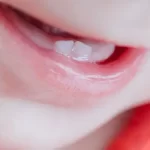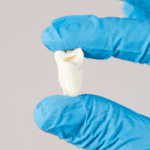The appearance of the first tooth is perhaps one of the most anticipated and cutest events in a baby’s life that most parents look forward to. While it may not be the most pleasant experience for some babies, it definitely marks one of the “firsts” in a baby’s life. When the first tooth erupts, it signifies that a baby is ready to transition from mashed to semi-solid food.
So as a baby grows into a toddler, all primary teeth would pop out gradually. It is at this stage that some parents witness tooth discoloration on their toddlers. This incident causes worry for some parents, so let’s find out everything you need to know about toddler tooth discoloration.
An Overview of Toddler Teeth
When babies reach six months, it is expected that their first tooth will make its appearance. As soon as babies turn three, their mouths would have had a full set of teeth. Usually, the first tooth to erupt is the central incisor, followed by the lateral incisors, and eventually the molars on the upper teeth. By the time the first set of teeth erupts, parents are highly encouraged to consult a dentist in order to gain knowledge on how to practice proper hygiene for a toddler’s teeth.
The child’s doctors – the pediatrician and the dentist – will probably suggest adding Fluoride-rich foods in order for a child’s teeth to develop enamel and prevent tooth decay.
What Is Tooth Discoloration?
No matter how attentive or careful we are with our child’s general health, there will be instances when we experience certain concerns with our child, for instance, toddler tooth discoloration. It may not be obvious at first, but the discoloration of the teeth may be a symptom of an underlying dental disorder.
What Causes Tooth Discoloration On Toddlers?
Adult teeth have a thicker enamel covering compared to the teeth of toddlers. As such, toddlers’ teeth are more susceptible to discoloration. Given such, tooth discoloration can happen to any toddler. While it’s a common condition to have, it doesn’t mean that you will ignore your child’s dental hygiene. There are several reasons toddlers experience discoloration on their teeth, but here are the most common causes.
1. Improper Hygiene
When a child starts eating a variety of food, it is important to observe proper dental hygiene. Brushing the teeth after every meal can help prevent toddler tooth discoloration. Plaque build-up can happen when proper hygiene is not observed, and this will cause discoloration.
2. Dental Trauma or Accident
It is expected for children to be hyperactive during their toddler stage. Their hyperactivity can sometimes lead to accidents. When the teeth receive a blow, blood vessels can sometimes erupt, causing a blackish discoloration to the affected tooth.
3. Diet
When children eat too much sugar-rich food like candies, soda, and desserts, toddler tooth discoloration may occur. Too much intake of acidic foods can affect the enamel protecting the teeth, and this can also result in a dull, grayish color of the teeth.
4. Enamel Hypoplasia
This disorder occurs when the teeth’ process of creating enamel is disturbed, resulting in a thin layer of enamel. Thin enamel permits plaque and other bacteria to prey on the teeth, causing toddler tooth discoloration.
5. Hyperbilirubinemia
Bilirubin is a yellowish pigment that is produced when red blood cells break down. Too much bilirubin causes hyperbilirubinemia, which is exhibited by the yellowing of the skin, nails, and teeth.
6. Fluorosis
When there is an abundance of fluoride intake in the body, it often manifests as fluorosis or changes in the appearance of the enamel surface. This can be categorized as mild or moderate. In cases of severe fluorosis, discoloration happens, and a doctor’s appointment is needed.
7. Medication
If a child is taking medication for an existing infection, it is expected to affect the color of the tooth. Medications that cause tooth discoloration include tetracycline and doxycycline, both of which are antibiotics.
What to Do When Experiencing Tooth Discoloration After Trauma?
Since toddlers are full of energy, they can be all over the place. It is not surprising when suddenly a toddler will bump their mouth onto a hard surface. As mentioned, when the teeth experience blunt force trauma, the blood vessels inside will rupture, causing a deep red to blackish color.
As a parent, this shouldn’t cause any worries on your end because teeth discoloration after trauma is quite a normal occurrence. All you need to do is to let the tooth or teeth alone. After a few days, the bruise will eventually subside. It is only normal if the tooth has a small chip.
However, when the tooth is accidentally knocked out because of an injury, it is best to visit a dentist to ensure that nothing serious has happened. Continue the observation and be wary when your toddler develops a fever or when an abscess leaks from the area. When this happens, consult a doctor immediately for tooth discoloration antibiotics.
How to Take Care of Toddler Teeth to Avoid Discoloration of The Teeth
Practicing good hygiene is the best way to avoid discolored teeth. As a parent, it is highly important to ensure that a toddler’s teeth are brushed twice a day or after each meal. In brushing a toddler, you should have good access to the mouth in order to observe and see.
If a toddler’s tooth is only starting to come out, clean the mouth by using a clean, damp gauze and carefully dab in the area of the swollen gums and the protruding tooth. However, if the teeth are already out, use a soft and small toothbrush, apply a little amount of toothpaste, and carefully brush their teeth. Toddlers are expected not to know how to spit. It is also important that you put only a tiny amount of toothpaste on their toothbrush.
Advanced Dental Group to Care For Your Toddler’s Teeth
While discoloration on a toddler’s tooth is common, regular dental visits teach your toddler one of the proper ways of taking care of the teeth. We, at Advanced Dental Group, are one with you in helping your child develop and practice good dental hygiene. Our affiliate dentists are always at your service. Do call us for any inquiries you may have.





